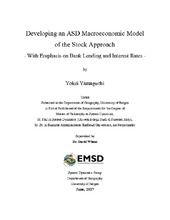Developing an ASD Macroeconomic Model of the Stock Approach - With Emphasis on Bank Lending and Interest Rates -
Master thesis
Permanent lenke
https://hdl.handle.net/1956/16473Utgivelsesdato
2017-08-23Metadata
Vis full innførselSamlinger
- Department of Geography [627]
Sammendrag
The financial crisis in 2008 evidenced an over-simplification of the role of banks made in the majority of macroeconomic models. Based on Accounting System Dynamics (ASD) modeling approach, the current research presents a model that incorporates banks as creators of deposits when making loans as opposed to the conventional view of banks as intermediaries of existing money. The generic model thus developed consists of five sectors; production, household, banking, government and central bank to better understand interrelationships among five sectors and to explorer how monetary and production sector interact. The model turns out to produce diverse macroeconomic behaviors driven by interactions of reinforcing and balancing feedback loops. Some of them are: 1. Variability of money stock under stable base money due to endogenous deposit creation, 2. Short-term business cycles triggered by two different sources, 3. Temporary alleviation of GDP gap by monetary easing policy and its limitation for counteracting deflationary trend, 4. Different macroeconomic effects induced by the same fiscal policy implemented under different economic conditions, 5. Macroeconomic instabilities triggered by credit crunches and a shock in currency holding ratio. Simulation experiments under different scenarios highlight the importance of building a macroeconomic model where banks supply the majority of money stock. We believe that this generic ASD macroeconomic model of the stock approach could provide a foundation for actual macroeconomic analyses based on historical economic data.
